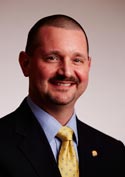
Thomas S. Roukis, DPM, PhD, FACFAS
ACFAS President
As I write this article, I am in Spain preparing to speak about thehistorical perspective of central metatarsal osteotomies. L. Samuel Barouk, MD,and his son, Pierre Barouk, MD, are to my right. Talk about intimidating.
It takes me about 30 hours of dedicated time over many weeks to create a new presentation. I start by thinking about the topic, first in general terms, then I dig through the file cabinet in my home office closet where I have the brochures and handouts from every meeting I have attended since 1993.I review what has been done and by whom and make sure I avoid similar approaches or if I really like what was done I credit the original presenter.
After this, I perform an “electronic” systematic review of the literature using an online search engine and request anything I cannot acquire online from my hospital’s library. I first look at all figures and tables, then the abstract and finally read the entire paper if it will help me with the presentation. My kids even get into the act. My 2-year-old son loves to “zoom”through my strategically arranged piles of papers with his monster truck dujour and is an expert in removing my intricately aligned post-it notes to create speed bumps in the hallway. Meanwhile, my 7-year-old daughter likes to reorganize the papers according to degree of “ouchy pictures.”
Regardless of my children’s “help,” the next step is to look through my files for pictures supplemented with an Internet search and a PDF manuscript file search for images that will enhance my presentation. I then start building the presentation, usually by jumping from one slide to the next and moving them in order myriad times. This is followed by adding backgrounds to each text box (makes reading the words contained easier), an outline to each picture (makes them stand out), converting the radiographs to grayscale (this eliminates the green hue regular radiographs have), and adding animation (which gives me a mental break for half a second to prepare for the next image and discussion point). I then re-review the literature for any recently published works that need to be included in my presentation, which is always followed by a long sigh when identified.
The final step is to add a picture of my kids to the “thank you” slide. This last point is exceedingly important to me because although I try to only do the above work after my kids have gone to sleep, the reality is that I have spent countless hours toiling away on my computer working on presentations when I really should have been spending time with them. So the “thank you” is for them and they love to see which picture of them I included in the presentation when I show them the final product.
Thankfully, in Spain one of the translators was born and raised in Vermont and was able to translate my “American English” into Spanish that the audience could understand. Interestingly, nearly the entire question and answer session revolved comparing the benefits and complications of traditional open and percutaneous Weil osteotomies. I responded with some general comments that Lowell Scot Weil, Sr, DPM, FACFAS, told me when I was a fellow, as well as some of my personal observations. The bottom line for me is: What is the patient’s tolerance for complications? If they cannot tolerate stiffness, or their vascular supply is questionable, then percutaneous approaches win. If they cannot tolerate persistent edema for months, or have isolated metatarsal pathology such that multiple osteotomies are inappropriate, then open approaches are best. It seems that the audience and faculty were able to agree only on one point: central metatarsal surgery is difficult to perform well and care must betaken in patient and procedure selection.
ACFAS recognizes this and has developed “complications and revision surgery” tracks on various foot and ankle pathology at the Annual Scientific Conference, the Surgical Skills Courses and our ACFAS Coming to You Regional Programs. It is a small world, but you need not travel the world to take advantage of the world-class educational offerings provided by the College.
